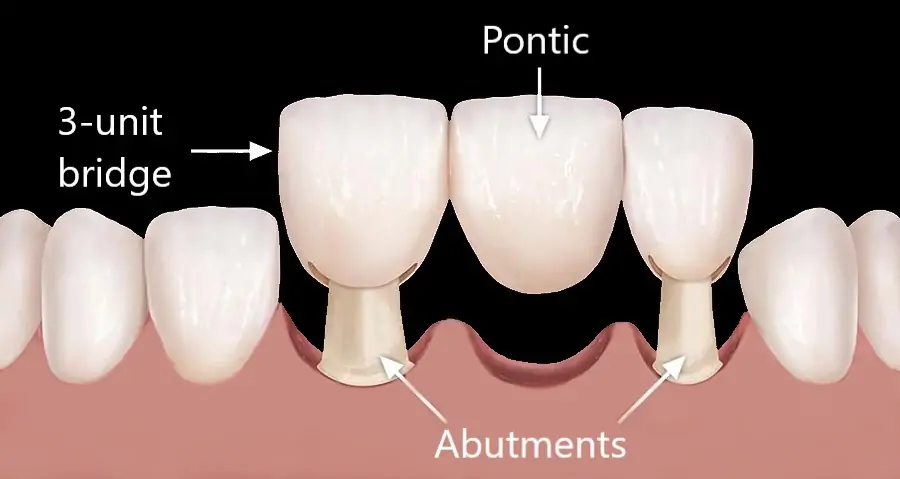
Dental bridge is a ceramic or porcelain dental prosthesis used for missing teeth and /or as abutment. It can be used for fixing a natural tooth or restoring a dental implant. It consists of a series of several dental crown and/or pontic, which will be fabricated by a well-experienced dental laboratory according to the measurements taken by the dentist. During this period, the dentist will place a temporary bridge to protect the teeth and gum of the area before preparing the permanent bridge.
Dental Bridges;
- Restore your smile, the ability of proper chewing, biting and speaking
- Sustain the shape of your face
- Prevent from drifting of remaining teeth

What is a Bridge Tooth?
A dentistry procedure that involves placing teeth between two teeth on the right and left to close the gap that occurs due to tooth loss is called a bridge tooth. Within the scope of this procedure, the teeth on the right and left of the missing tooth to be bridged are reduced and the old gap is closed with a bridge tooth.
A bridge tooth is one of the most commonly used traditional treatment methods to eliminate tooth loss. The most common causes of tooth loss are gum disease, gum recession, traumas and untreated tooth decay. Over time, the face and jaw anatomy deteriorates due to tooth loss. Especially when there is more than one tooth loss, speech disorders may even occur. Therefore, the gaps caused by tooth loss must be filled. Even if a single tooth is missing in the mouth, the other teeth move down, up, right or left over time towards the empty space. When the person’s mouth and tooth structure deteriorate, chewing difficulties and pain may occur due to the increased load on the other teeth.
Gaps that occur during smiling due to tooth loss can also cause people to experience aesthetic concerns. Treating tooth loss is important for health as well as for the person to be comfortable and confident in their social life. Eating difficulties, speech difficulties and aesthetic concerns caused by tooth loss can be eliminated with dental bridge treatment.
What are the Types of Dental Bridges?
There are different methods that can be preferred in dental bridge treatment. After examining the patient’s mouth, teeth and jaw structure, the type of dental bridge to be preferred is determined.
- In traditional dental bridge treatment, the healthy teeth on the right and left of the missing teeth are filed down and reduced in size and used as bridge abutments to fix the bridge. A dental bridge prosthesis is placed on the fixed teeth.
- Maryland (Winged) bridge treatment is applied by bonding the bridge to the neighboring teeth. The tooth is prepared to fill the tooth gap and is bonded to the back of the neighboring teeth next to the gap. Healthy teeth are not cut in this method. However, since it is applied with the bonding method, its durability is less than other types of dental bridges.
- Implant-supported bridges are usually preferred in cases where more than one tooth is lost. In the implant-supported bridge method, which is applied without cutting healthy teeth, multiple tooth losses are eliminated by filling the place of missing teeth with an implant bridge screwed into the jawbone.
- In metal-supported porcelain bridges, there is a metal substructure at the bottom and a porcelain coating on top. It is the preferred type of bridge in order to increase durability and withstand more chewing force.
How is a Dental Bridge Applied?
Dental bridge application can be defined as the placement of a prosthesis in place of missing teeth or teeth that have been lost for various reasons. The dental bridge is usually placed on neighboring healthy teeth, ensuring that the healthy teeth support the bridge prosthesis.
The first step in dental bridge application is to examine the missing teeth and evaluate the oral structure. The dentist determines the most appropriate treatment plan for the person by using x-rays or other imaging methods. A small amount of enamel may need to be removed to support healthy neighboring teeth. The reason for this procedure is to prepare the teeth for carrier crowns.
The dentist takes measurements based on the oral structure and the prepared teeth. The measurements taken are sent to the laboratory to form the basis for the construction of the bridge prosthesis. While the permanent bridge prosthesis is being prepared, a temporary prosthesis or temporary bridge is placed. In this way, the missing tooth is corrected in terms of aesthetics and functionality.
When the permanent bridge prosthesis is prepared, the prosthesis is placed on the neighboring teeth. At this stage, it is necessary to make sure that the prosthesis fits correctly and is compatible. Compliance and aesthetic checks are performed to determine that the prosthesis fits correctly in the mouth and does not interfere with the chewing function. Factors such as tooth color, shape and size are adjusted specifically for the patient. If the bridge prosthesis is placed correctly, the bridge dental treatment is completed with the final checks.
What are the advantages of a dental bridge?
Dental bridge treatment is a common dental solution applied to fill the gaps created by tooth loss and to eliminate aesthetic and functional problems. Bridges can be manufactured in the color and form of natural teeth. It provides the replacement of missing teeth in an aesthetic way. Aesthetic disorders and asymmetries that may occur due to missing teeth can be eliminated with a dental bridge, and a more uniform and attractive smile can be achieved.
The chewing function that is impaired due to missing teeth can be restored with a dental bridge. In this way, better breakdown and digestion of nutrients are ensured. Tooth loss can make it difficult to pronounce sounds correctly during speech. Dental bridges eliminate these difficulties and provide clearer speech.
Over time, tooth loss can lead to shifting of other teeth and jaw bone problems. Dental bridges help prevent such complications. Other teeth can move over time due to the gaps created by missing teeth. Bridges prevent this situation and keep the position of the teeth fixed.
Dental bridge treatment is applied by dentists in line with the patient’s individual needs. Therefore, it should be determined after a professional evaluation whether it is suitable for each patient.
Who Can Have Dental Bridge Treatment?
Dental bridge treatment is basically suitable for everyone who has missing teeth and wants to eliminate these tooth deficiencies. The suitability of the treatment should be evaluated on a person-specific basis.
- Dental bridge treatment is considered a suitable solution for those who have one or more missing teeth. Aesthetic problems caused by missing teeth can be eliminated with dental bridge treatment.
- Since dental bridges are based on healthy neighboring teeth, neighboring teeth should be healthy. If there is damage, decay or serious wear on neighboring teeth, these problems should be treated first.
- The general oral health of the person who will receive dental bridge treatment should be good. Chronic oral health problems such as gum disease can negatively affect dental bridge treatment.
- People who will receive dental bridge treatment should apply a correct and complete oral care routine after treatment.
- The general health of people who will receive dental bridge treatment should not be an obstacle to treatment.
What Should Be Considered After Dental Bridge Treatment?
Since good care is needed after dental bridge treatment, it is very important to maintain complete oral hygiene. In this context, teeth should be brushed at least twice a day, and dental floss and interdental cleaners should also be included in the dental care routine.
Hard and sticky foods should not be consumed to increase the durability of the new bridge tooth. Care should also be taken regarding foods that are too hard or difficult to chew. It should not be neglected to go for check-ups at the periods recommended by the dentist. The dentist evaluates the condition of the bridge tooth and performs the necessary cleanings, and can thus diagnose potential problems early.
If the dentist recommends a night plate or night guard, these should be used regularly. Such devices can help protect teeth and prevent grinding problems. Since teeth grinding habits can damage bridge teeth, it is necessary to consult a dentist in such cases. Smoking and alcohol consumption should be limited as they can negatively affect teeth and reduce the durability of the bridge tooth.
Working Hours
- Monday: 09:00 – 18:00
- Tuesday: 09:00 – 18:00
- Wednesday: 09:00 – 18:00
- Thursday: 09:00 – 18:00
- Friday: 09:00 – 18:00
- Saturday: 09:00 – 18:00
- Sunday: Closed
